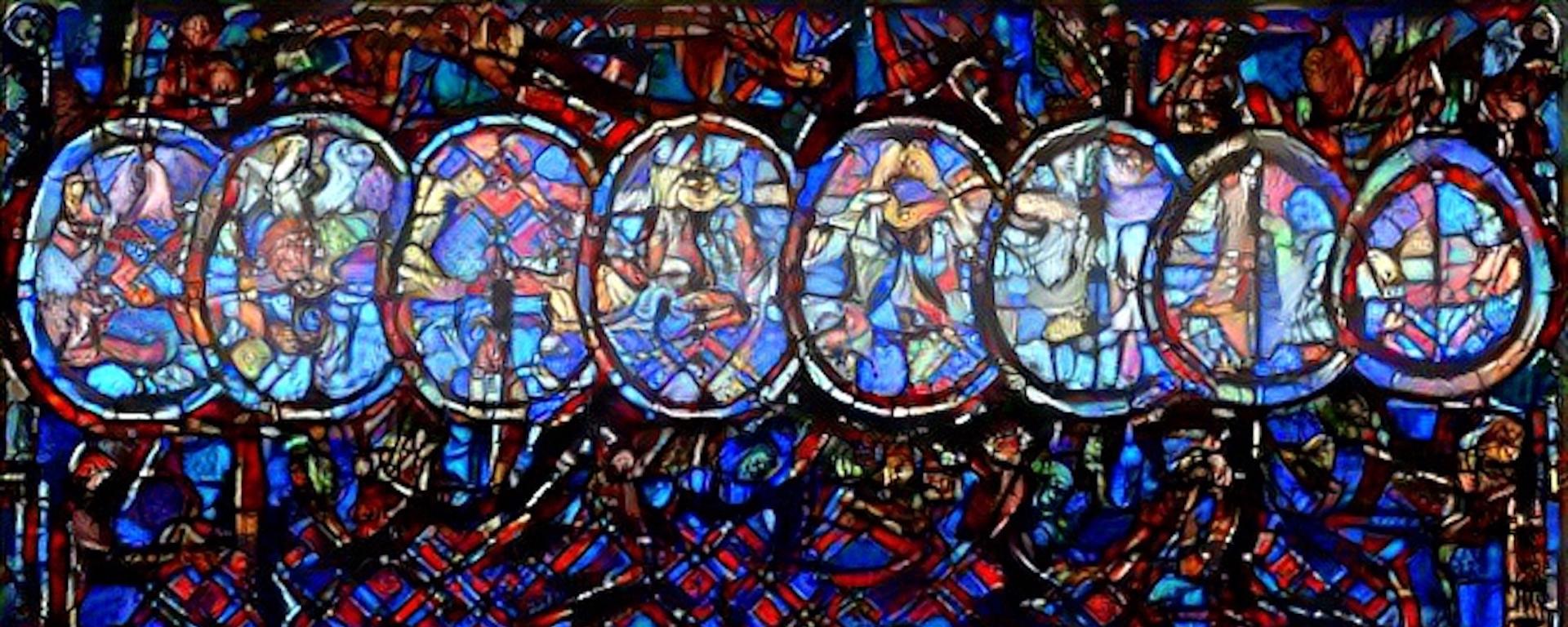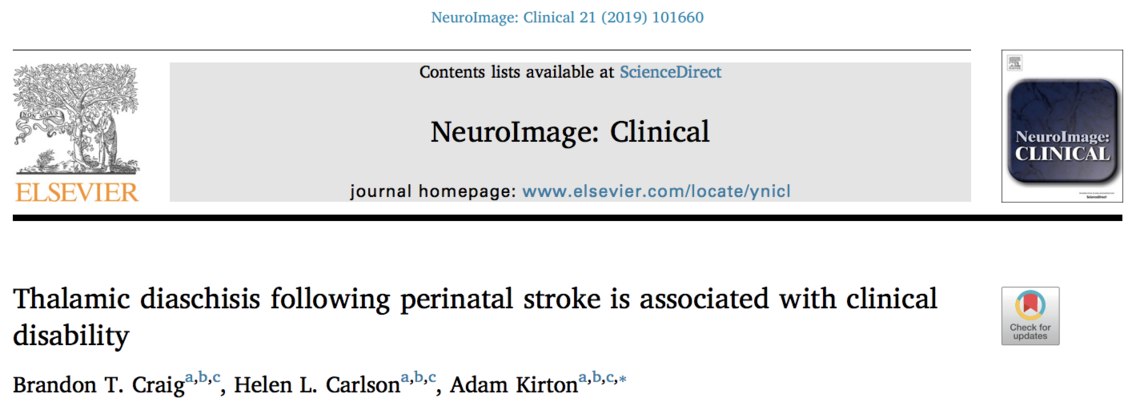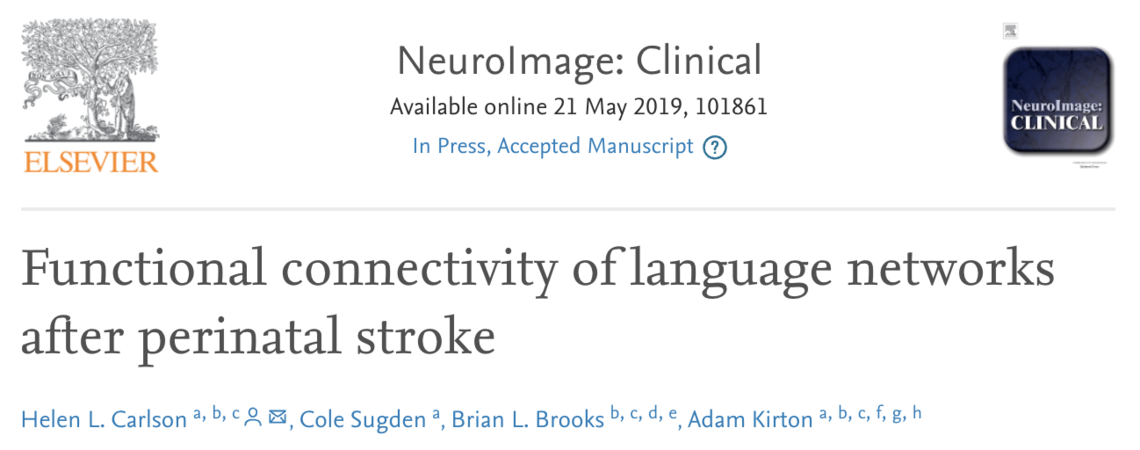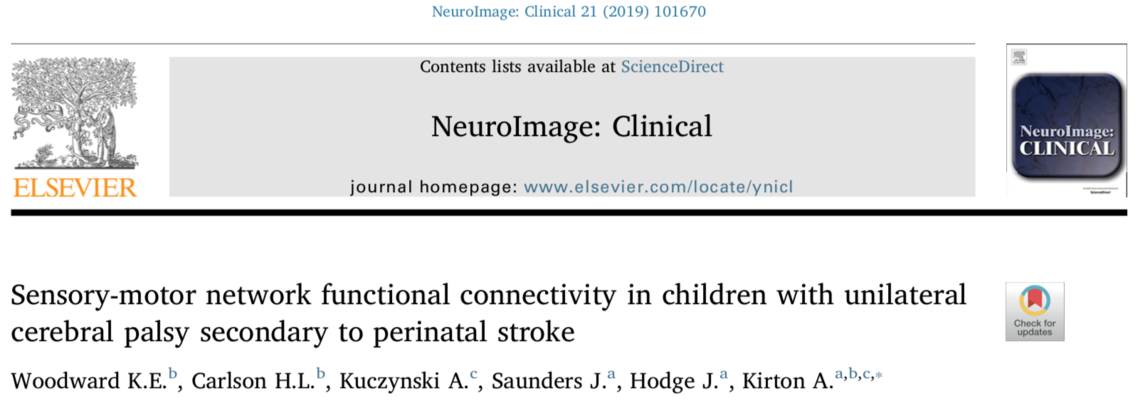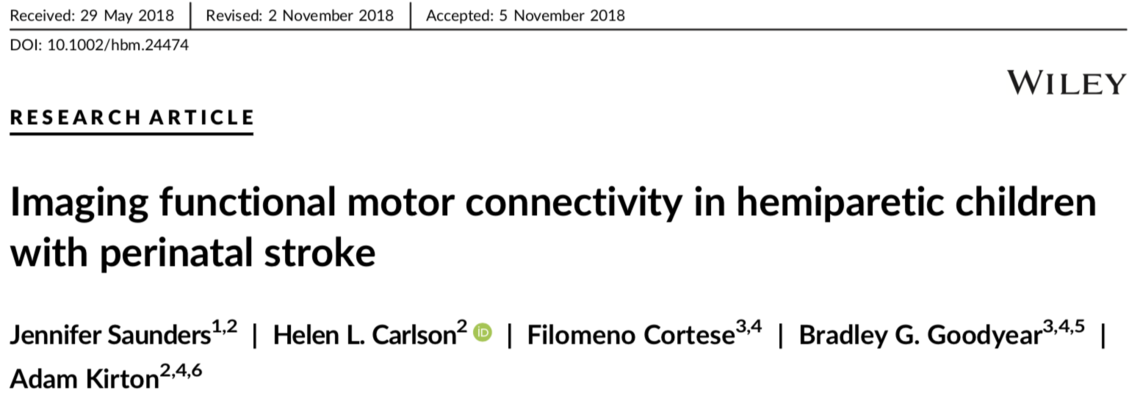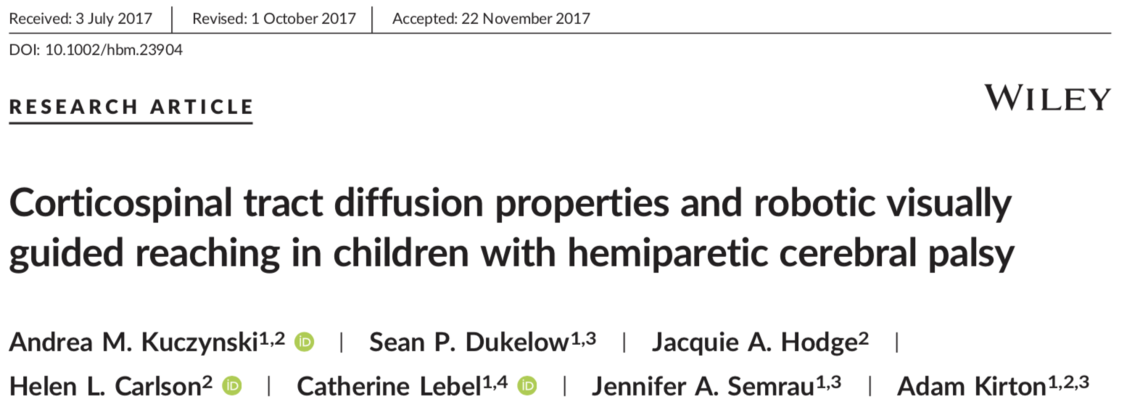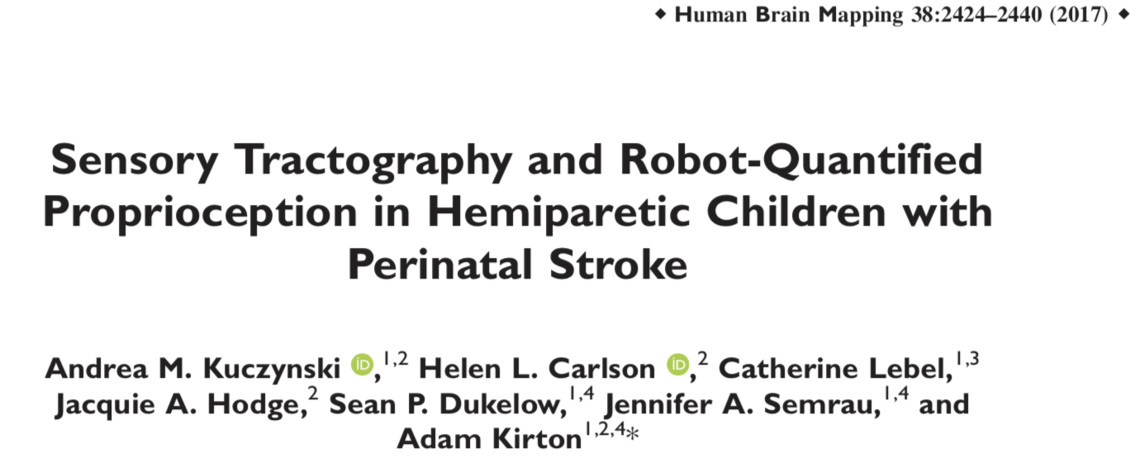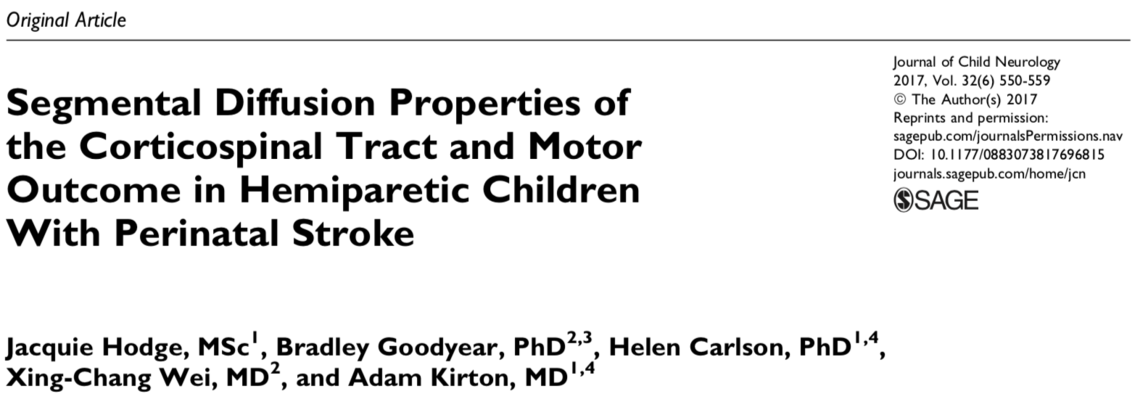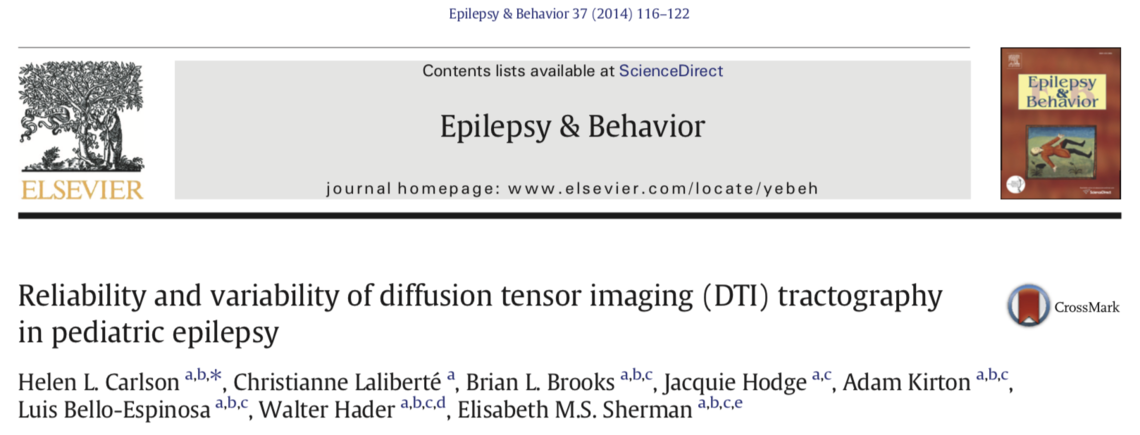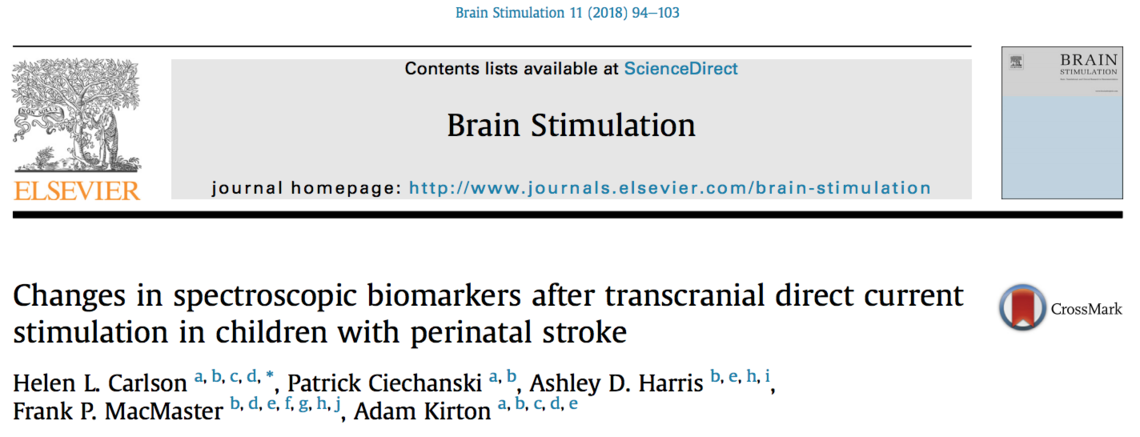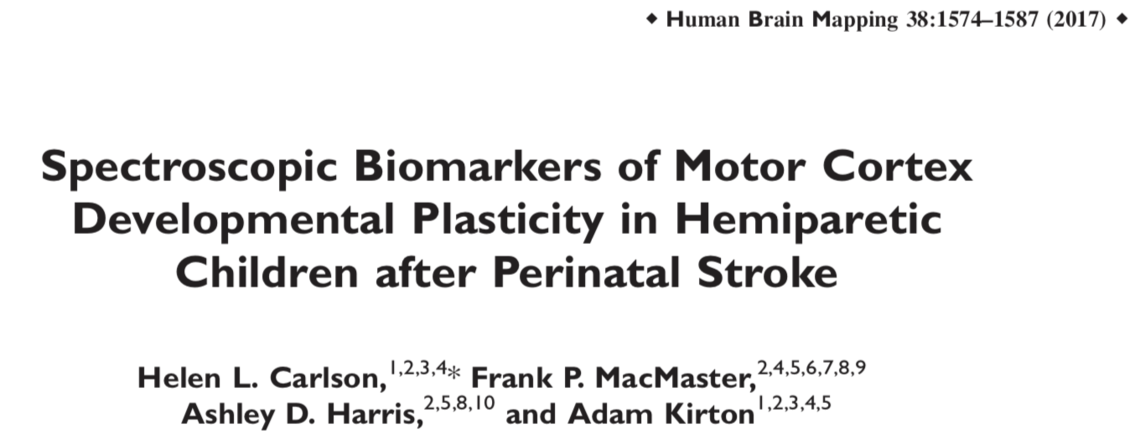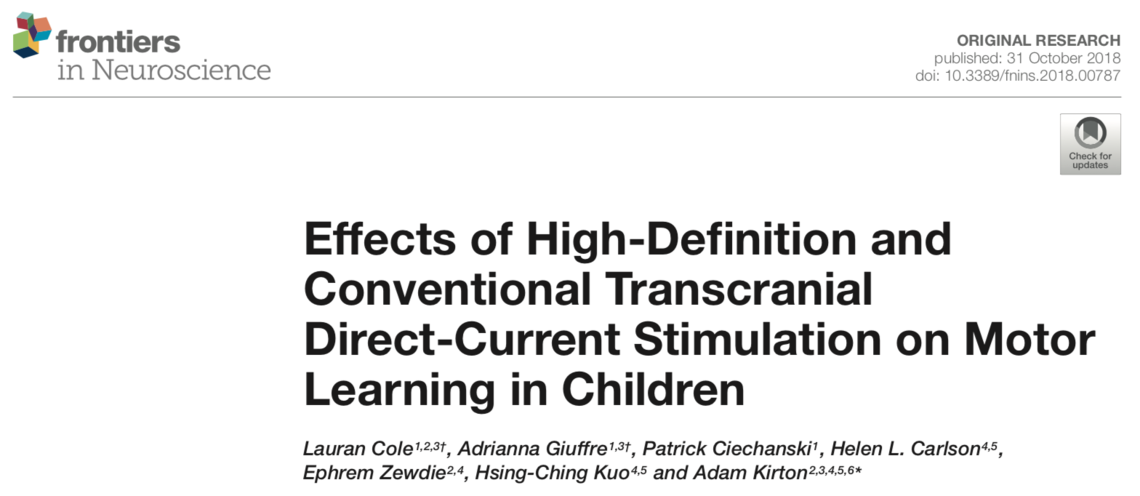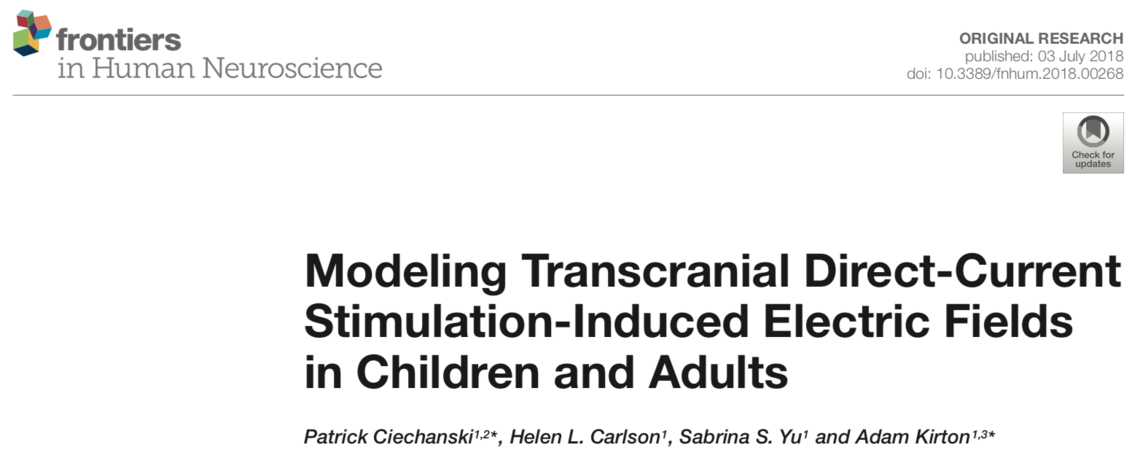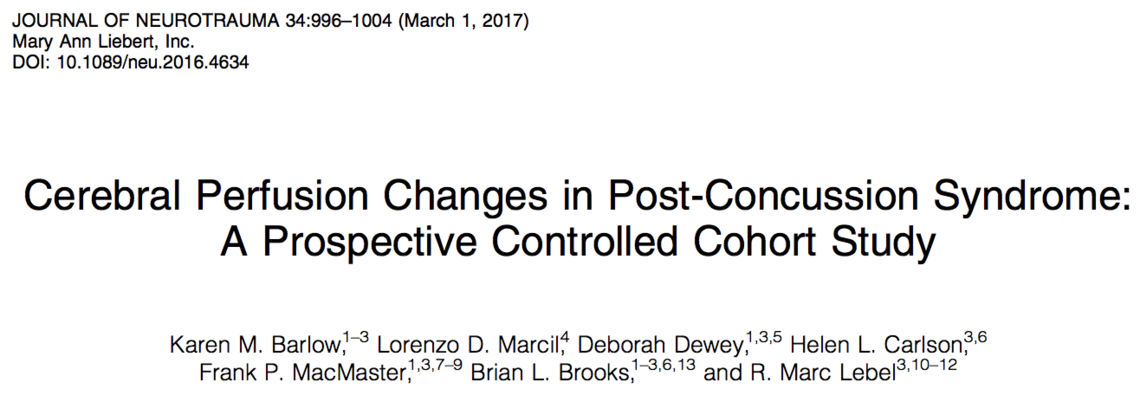Anatomy
Cerebral diaschisis in nAIS
Diaschisis refers to changes in brain areas functionally connected but structurally remote from primary injury. Acute diffusion weighted imaging in babies immediately after stroke (neonatal arterial ischemic stroke (nAIS)) was used to quantify cerebral diaschisis in the thalamus, corpus callosum, cerebral peduncle and caudate. While cerebral diaschisis was present in many babies, the degree of diaschisis was not related to motor outcomes.
Srivastava R, Rajapakse T, Carlson HL, Kees J, Wei X-C, Kirton A (in press). Diffusion Imaging of Cerebral Diaschisis in Neonatal Arterial Ischemic Stroke. Pediatric Neurology. View
Thalamic diaschisis
Diaschisis refers to alterations in brain structures remote from, but connected to, stroke lesions. We measured thalamic volumes after perinatal stroke and found that ipsilesional volume loss was not associated with clinical motor function. Contralesional volume was inversely correlated with clinical motor function, suggesting the thalamus is involved in the known developmental plasticity that occurs in the contralesional hemisphere after early unilateral injury.
Craig B, Carlson HL & Kirton A. (2019). Thalamic diaschisis following perinatal stroke is associated with clinical disability. Neuroimage: Clinical, 21, 101660. View
Crossed cerebellar atrophy
We measured crossed cerebellar atrophy (CCA), a chronic cerebellar volume loss following contralateral motor pathway injury, in children after perinatal stroke. Larger ipsilesional cerebellar volume was associated with poorer cognitive and motor outcomes.
Craig B, Olsen C, Mah S, Carlson HL, Wei X-C & Kirton A (2019). Crossed cerebellar atrophy in perinatal stroke. Stroke, 50, 175-177. View
Alterations in myelination after perinatal stroke
Myelination of apparently uninjured brain in both the ipsilesional and contralesional hemispheres is decreased after perinatal stroke. Differences appear to radiate outward from the lesion. Further study is needed to determine clinical significance.
Yu S, Carlson HL, Mineyko A, Brooks BL, Kuczynski A, Hodge J, Dukelow S & Kirton A (2018). Bihemispheric alterations in myelination in children with unilateral perinatal stroke. Neuroimage: Clinical, 20, 7-15. View
Diaschisis in acute childhood AIS
We demonstrate that diffusion imaging may detect changes in brain structures remote from but connected to acute arterial ischemic stroke (AIS) lesions in children. These changes were associated with subsequent cognitive and motor outcomes.
Kirton A, Williams E, Dowling M, Mah S, Hodge J, Carlson HL, Wei X, Ichord R & PedNIHSS Investigators (2016). Diffusion imaging of cerebral diaschisis in childhood arterial ischemic stroke. International Journal of Stroke, 11(9), 1028-1035. View
Functional Connectivity
Functional connectivity of language networks
We measured organization of language networks after perinatal stroke and found that children with left hemisphere stroke may develop compensatory right-lateralization of language and that children with arterial strokes showed less connectivity than venous and controls. Lower connectivity is associated with poorer language comprehension performance and these findings may inform language interventions and instructional strategies.
Carlson HL, Sugden C, Brooks BL & Kirton A. (in press). Functional connectivity of language networks in perinatal stroke. Neuroimage: Clinical, 101861. View.
Sensorimotor functional connectivity
Resting state fMRI measures of sensorimotor functional connectivity were associated with clinical sensorimotor function in children with unilateral cerebral palsy secondary to periventricular venous infarction.
Woodward KE, Carlson HL, Kuczynski A, Saunders J, Hodge J & Kirton A (2019). Sensory-motor network functional connectivity in hemiparetic children with perinatal stroke. Neuroimage: Clinical, 21, 101670. View
Motor functional connectivity after stroke
Both arterial ischemic stroke (AIS) and periventricular venous infarction (PVI) can damage motor pathways. We investigated resulting alterations in functional motor networks and probed function. We found significant differences in both strength and laterality of motor network connections for AIS but not PVI. Function was not related to connectivity.
Saunders J, Carlson HL, Cortese F, Goodyear B & Kirton A. (2019). Imaging functional motor connectivity in children with perinatal stroke. Human Brain Mapping, 40, 1632-1642. (Our sensorimotor art is featured on the cover of this issue). View
Structural Connectivity
Motor tractography and proprioception
Using diffusion tensor imaging, we investigated the relationship between corticospinal tract diffusion properties and robotic visually guided reaching in children with hemiparetic cerebral palsy. We found that diffusion properties of the lesioned CST are altered after perinatal stroke, the degree of which correlates with specific elements of visually guided reaching performance.
Kuczynski AM, Hodge JA, Carlson HL, Lebel C, Dukelow SP, Semrau JA & Kirton A (2017). Corticospinal tract diffusion properties and robotic visually guided reaching in children with hemiparetic cerebral palsy. Human Brain Mapping, 39(3), 1130-1144. View
Sensory tractography and proprioception
We aimed to characterize the relationship between sensory (dorsal column medial lemniscus (DCML)) pathway connectivity and proprioceptive dysfunction in children with perinatal stroke using a proprioception robot. Both arterial and venous stroke groups demonstrated impairments in proprioception that correlated with lesioned hemisphere DCML tract diffusion properties.
Kuczynski AM, Carlson HL, Lebel C, Hodge JA, Dukelow SP, Semrau JA & Kirton A (2017). Sensory tractography and robot-quantified proprioception in hemiparetic children with perinatal stroke. Human Brain Mapping, 38(5), 2424-2440. View
Cortical spinal tract properties in CP
We used diffusion tensor imaging to assess corticospinal tract diffusion properties in hemiparetic children with perinatal stroke and found differences compared to peers. Correlations with disability support clinical relevance and utility in model development for personalized rehabilitation.
Hodge J, Goodyear B, Carlson HL, Wei X & Kirton A (2017). Segmental diffusion properties of the corticospinal tract and motor outcome in hemiparetic children with perinatal stroke. Journal of Child Neurology, 32(6), 550-559. View
DTI tractography in pediatric epilepsy
In a group of children with epilepsy, we isolated multiple major white matter tracts using diffusion tensor imaging tractography. We demonstrate that even in brains of children with neurological disease, tractography methods are reliable.
Carlson HL, Laliberte C, Brooks BL, Hodge J, Kirton A, Bello-Espinosa L, Hader W & Sherman EMS (2014). Reliability and variability of diffusion tensor imaging (DTI) tractography in pediatric epilepsy. Epilepsy & Behavior, 37, 116-122. View
Neurometabolites
tDCS changes neurometabolite concentrations
We found that certain brain metabolites found in the motor cortices of kids with perinatal stroke had different concentrations compared to control participants and changed after non-invasive brain stimulation (tDCS). Concentrations of some of these metabolites were also highly correlated with motor function.
Carlson HL, Ciechanski P, Harris AD, MacMaster FP, Kirton A (2018). Changes in spectroscopic biomarkers after transcranial direct current stimulation in children with perinatal stroke. Brain Stimulation, 11, 94-103. View
Spectroscopic biomarkers in kids with CP
Using magnetic resonance spectroscopy (MRS), we demonstrate that certain neurometabolites in the motor cortices of children with hemiparetic cerebral palsy are different compared to their peers. Concentrations of such neurometabolites are highly related to function, giving us a biomarker for brain plasticity after perinatal stroke.
Carlson HL, MacMaster FP, Harris AD & Kirton A (2017). Spectroscopic biomarkers of motor cortex developmental plasticity in hemiparetic children after perinatal stroke. Human Brain Mapping, 38(3), 1574-1587. View
Intervention Trials
High-definition tDCS in kids
We investigated whether high-definition transcranial direct current stimulation (HD-tDCS) can improve motor learning in children. We found enhanced motor learning effects in the trained hand but also significant spillover into the untrained hand suggesting generalization of improvements and thus potential efficacy as a rehabilitation intervention.
Cole L, Giuffre A, Ciechanski P, Carlson HL, Zewdie E, Kuo H-C, Kirton A (2018). Effects of High-Definition and Conventional Transcranial Direct-Current Stimulation on Motor Learning in Children. Frontiers in Neuroscience, 12, 787. View
tDCS may improve motor function in kids with CP
The addition of transcranial direct current stimulation (tDCS) to intensive rehabilitation therapy may increase motor function in children with perinatal stroke and hemiparetic cerebral palsy.
Kirton A, Ciechanski P, Zewdie E, Anderson J, Nettel-Aguirre A, Carlson HL, Carsolio L, Herrero M, Quigley J, Mineyko A, Hodge J & Hill M (2017). Transcranial direct current stimulation for children with perinatal stroke and hemiparesis. Neurology, 88(3), 259-267. View
Treatment of dysphasia after childhood stroke
Intensive speech rehabilitation combined with repetitive transcranial magnetic stimulation can improve language function after childhood stroke. We report here associated multimodal imaging biomarkers.
Carlson HL, Jadavji Z, Mineyko A, Damji O, Hodge J, Saunders J, Hererro M, Nowak M, Patzelt R, Mazur-Mosiewicz A, MacMaster FP, Kirton A (2016). Treatment of dysphasia with rTMS and language therapy after childhood stroke: Multimodal imaging of plastic change. Brain & Language, 159, 23-34. View
Motor Mapping
Visualization of robotic motor mapping
A step-by-step visualized guide demonstrating how to perform transcranial magnetic stimulation (TMS) robotic motor mapping in children.
Giuffre A, Cole L, Kuo H-C, Carlson HL, Grab J, Kirton A & Zewdie E (in press). Non-invasive modulation and robotic mapping of motor cortex in the developing brain. Journal of Visualized Experiments. View
Robotic TMS mapping in kids
We aimed to use recently pioneered robotic TMS technology to develop an efficient, reproducible protocol to characterize cortical motor maps in a pediatric population. We demonstrated that motor map neurophysiology and its influence on developmental plasticity and therapeutic neuromodulation can be effectively explored in children.
Grab JG, Zewdie E, Carlson HL, Kuo H-C, Ciechanski P, Hodge J, Giuffre A & Kirton A. (2018). Robotic TMS mapping of motor cortex in the developing brain. Journal of Neuroscience Methods, 309, 41-54. View
Current Modeling
Current modeling during brain development
We used current modeling techniques to determine the strength and distribution of tDCS-induced electric fields (EF) in brains across the developmental period (6-43 years). We found large EF differences between children and adults that may be associated with age-related differences in skull and extra-axial space thickness, as well as developmental changes occurring in grey and white matter.
Ciechanski P, Carlson HL, Yu S & Kirton A (2018). Modeling transcranial direct-current stimulation-induced electric fields in children and adults. Frontiers in Human Neuroscience, 12, 268. View
Epilepsy and Stroke
Epileptiform discharges in sleep and cognition
We investigated whether sleep-potentiated epileptiform abnormalities are associated with worse developmental outcomes after perinatal stroke. We found that developmental outcome in language and behaviour in children with arterial perinatal stroke is associated with electrical status epilepticus in sleep and possibly treatment of EEG abnormalities can improve outcome.
Mineyko A, Qi W, Carlson HL, Bello-Espinosa L, Brooks BL & Kirton A (2017). Neuropsychological outcome in perinatal stroke associated with epileptiform discharges in sleep. The Canadian Journal of Neurological Sciences. 44(4), 358-365. View
Mild Traumatic Brain Injury
Cerebral perfusion differences post concussion
We examined cerebral blood flow (CBF) in children with different clinical recovery patterns following mild traumatic brain injury (mTBI). Symptomatic children had higher CBF. Children who "recovered" quickly, had decreased CBF suggesting that clinical recovery precedes the cerebral recovery.
Barlow KM, Marcil LD, Dewey D, Carlson HL, MacMaster FP, Brooks BL & Lebel RM (2017). Cerebral Perfusion changes in Post-Concussion Syndrome: A prospective controlled cohort study. Journal of Neurotrauma, 34(5), 996-1004. View

